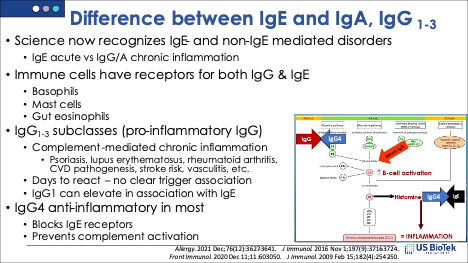4 Questions On NAD/NADH Testing Answered
Unlocking the Secrets of Cellular Energy
3 min read
![]() Dr. Andrea Gruszecki, ND
:
May 24, 2023 at 8:30 AM
Dr. Andrea Gruszecki, ND
:
May 24, 2023 at 8:30 AM

Humans and fungi have co-evolved on the planet, and most humans have the necessary physiological "machinery" to degrade and detoxify small amounts of mycotoxin exposure. Mycotoxins are mold metabolites that can, under certain circumstances, cause allergy, inflammation, or toxicity in humans and animals. Fungal infections, whether of specific organ systems (gut, vagina, skin, lung) or systemic, typically indicate the presence of a compromised immune system.
However, Mold-induced allergy or inflammation may be much more challenging to diagnose. Every patient is unique, and every symptom may arise from multiple causes. Food-borne or inhaled mold exposures may be contributing factors for patients with chronic upper respiratory problems.
Mold exposure typically occurs through ingestion or inhalation. Mycotoxins may be found in grains, dried nuts, dried fruits or fruit juices, coffee beans, meat, milk, and spices. Mycotoxins are usually degraded by phase I cytochrome P450 enzymes in the liver and mitochondria. If they are not degraded, mycotoxins may bioaccumulate in the body and affect not only mitochondrial functions but other aspects of physiology. Cytochrome P450 enzymes in the liver and mitochondria may not function effectively for several reasons, including genetics, nutritional deficiencies, comorbid inflammatory disorders, and toxic metal or chemical exposures. Other mitochondrial enzymes can also be affected, decreasing the amount of cellular energy produced and disrupting homeostatic immune functions (tolerance). Mitochondrial dysfunction increases inflammation and oxidative stress, further inhibiting liver phase I detoxification of mycotoxins.
grains, dried nuts, dried fruits or fruit juices, coffee beans, meat, milk, and spices. Mycotoxins are usually degraded by phase I cytochrome P450 enzymes in the liver and mitochondria. If they are not degraded, mycotoxins may bioaccumulate in the body and affect not only mitochondrial functions but other aspects of physiology. Cytochrome P450 enzymes in the liver and mitochondria may not function effectively for several reasons, including genetics, nutritional deficiencies, comorbid inflammatory disorders, and toxic metal or chemical exposures. Other mitochondrial enzymes can also be affected, decreasing the amount of cellular energy produced and disrupting homeostatic immune functions (tolerance). Mitochondrial dysfunction increases inflammation and oxidative stress, further inhibiting liver phase I detoxification of mycotoxins.
If not degraded some mycotoxins, such as aflatoxins and ochratoxins, can bind to and alter DNA expression. DNA-binding shifts immune responses and/or increases the risk of kidney damage, liver damage, congenital disabilities, or cancer. Animal studies indicate that other mycotoxins may alter the level of various blood cells, organ weights, gut microbiome diversity, and cholesterol. Levels of glutathione and antioxidants decreased, and inflammatory cytokines increased in these animals as well.
Inhalant mold exposure can provoke inflammation through a different route: allergy sensitization and antibody production. Multiple human studies have correlated mold inhalation with asthma and other upper respiratory symptoms (cough, wheezing, etc.). Human studies indicate that indoor dampness and moldy environments may increase the risk of asthma, dyspnea, wheezing, cough, respiratory infections, bronchitis, allergic rhinitis, eczema, and upper respiratory tract symptoms by 30-50%. There is also some early evidence that such mold exposures may contribute to depressive symptoms in certain individuals.
Children appear to be especially sensitive, and early-life mold exposure is associated with asthma development or exacerbation in pediatric populations. Studies indicate that visible mold is the highest predictor of pediatric upper respiratory infection in infants (< 1 year). However, mold-induced respiratory symptoms in any patient may be due to either true allergy (IgE sensitization) or non-IgE sensitization. US BioTek offers IgE testing for 15 different commonly encountered environmental molds. Non-IgE mechanisms typically induce inflammation via complement activation. The complement pathway may be further activated by chronic exposure to inflammatory IgG1-3 or IgA food sensitivities, worsening symptoms. Early-life mycotoxin exposure also induced neurocognitive effects in Polish children, who had significant decreases in IQ scores. More prolonged exposure further decreased IQ scores in subjects. 
It is easy to see why the evaluation of patients with chronic respiratory problems ideally includes:
Clinicians must determine the most likely cause for every symptom to restore health. Food-borne or inhaled mold exposures may be contributing factors for patients with chronic upper respiratory problems. Avoiding mold exposure is the first and most important action step for symptom reduction. Current studies do not support environmental mold spore assessments as estimates of exposure. Fortunately, IgE mold testing, IgG1-3 and IgA food sensitivity testing, and the MOE-Tox evaluation may help uncover unsuspected sources of inflammation or toxicity that can perpetuate chronic respiratory symptoms and prevent a full recovery.
Resources:
Hope J. A review of the mechanism of injury and treatment approaches for illness resulting from exposure to water-damaged buildings, mold, and mycotoxins. Sci World J. 2013 Apr 18;2013:767482.
Kraft S, Buchenauer L, Polte T. Mold, Mycotoxins and a Dysregulated Immune System: A Combination of Concern? Int J Mol Sci. 2021 Nov 12;22(22):12269.
Mendell MJ, Mirer AG, Cheung K, Tong M, Douwes J. Respiratory and allergic health effects of dampness, mold, and dampness-related agents: a review of the epidemiologic evidence. Environ Health Perspect. 2011 Jun;119(6):748-56.
Shamji MH, Valenta R, Jardetzky T, Verhasselt V, Durham SR, Würtzen PA, van Neerven RJJ. The role of allergen-specific IgE, IgG, and IgA in allergic disease. Allergy. 2021 Dec;76(12):3627-3641.
Shenassa ED, Daskalakis C, Liebhaber A, Braubach M, Brown M. Dampness and mold in the home and depression: an examination of mold-related illness and perceived control of one's home as possible depression pathways. Am J Public Health. 2007 Oct;97(10):1893-9.
Vojdani A, Campbell AW, Kashanian A, Vojdani E. Antibodies against molds and mycotoxins following exposure to toxigenic fungi in a water-damaged building. Arch Environ Health. 2003 Jun;58(6):324-36.

Unlocking the Secrets of Cellular Energy

Short chain fatty acids (SCFAs) are organic acids produced by bacterial fermentation of dietary fibre and resistant starch. Enterocytes and...

Zonulin has emerged as a popular marker to assess the integrity of the intestinal mucosal barrier. Discovered by Dr Alessio Fasano, Zonulin...